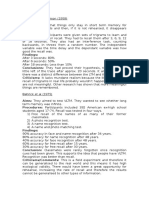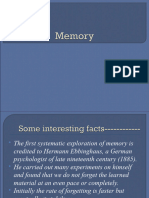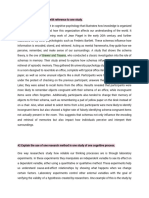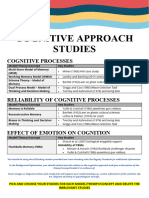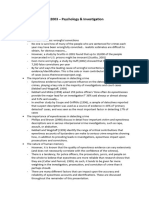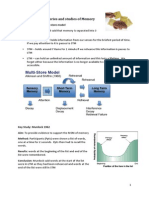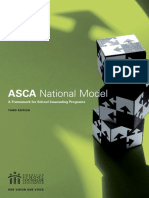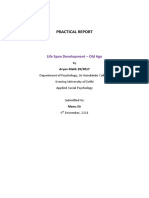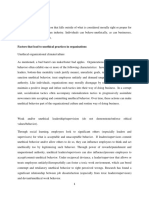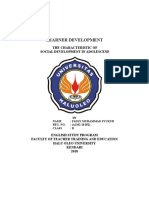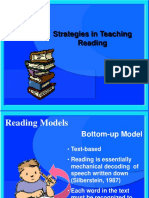Reconstructive Memory
Criteria B
● According to the reconstructive memory theory, memory is an active process
which involves reconstructing information.
● Studies have shown that the retrieval of information depends on schemas.
Thus, memory can be distorted because we use schemas to fill in the gaps of our
memory.
● Leading questions are questions that prompt a desired answer in the
participants. They are relevant in interrogation by police and in the courtroom.
● Loftus (a psychologist) believed that leading questions influenced the
reconstruction of memory. This is called misinformation effect.
○ Eyewitnesses may fill in the gaps with schemas such as stereotypes as a
result of the leading questions. These have damaging consequences.
● An example is Ronald Cotton who was wrongly sentenced to 11 years in prison
for rape when the victim (the eyewitness) claimed he was the rapist. It was only
after a DNA test that he was released.
Criteria C
Study #1: Loftus & Palmer (1974)
Experiment 1
Aim
To investigate whether memory was influenced by leading questions, specifically in
the estimation of speed of cars in an accident.
Procedure
1. Students were shown film recordings of traffic accidents and had to answer a
questionnaire about the accident.
2. There was one critical question in which the students were asked how fast the
car was going during the accident. The word “accident” was changed to varying
degrees of intensity for e.g. “hit”, “collided”, “smashed”.
a. Different words were used because they have different connotations
which trigger different schemas.
�Findings/Results
● The critical question where the words had a more intense connotation had a
higher estimate of speed.
● This is interesting because the participants all watched the same film.
Conclusion
● The researchers concluded that there were two interpretations of the findings.
● Response bias: U sing a verb with higher intensity such as “smashed” biases the
response to a higher estimate.
● Memory change: T he question may have caused the participant’s memory
representation to change.
○ For e.g. verb of higher intensity such as “smashed” may have caused the
subject to remember the memory as being more severe than it really was.
● To choose between these conclusions, a follow-up study was done.
Experiment 2
Aim
To investigate whether response bias or memory change was responsible for memory
distortion.
Procedure
1. Students had to watch a film with multiple-car accidents. Then they had to
answer a questionnaire which had the critical question from experiment 1.
2. Students were allocated into one of three groups: “smashed into each other”,
“hit each other” and a control group which wasn’t asked the question.
3. One week later, the participants had to complete another questionnaire without
watching the film.
a. The critical question here was whether there had been any broken glass.
Findings/Results
● The more intense the verb, the more likely it was that the participant answered
“yes” to the broken glass question.
Conclusion
● Concluded that there was actually a change in memory.
● They suggested that memory was influenced by their p
erception of the event
AND post-event information.
� ● Post-event information was integrated into the memory so it was impossible to
tell where the information had come from--whether it was part of perception
of post-event info.
● LTQs: relates to Bartlett’s theory of reconstructive memory i.e. people change
the details of an event when they recall it.
Criteria D
Evaluation of study
Sample bias
● Only students were used -- they’re not representative of the entire population
● It is also argued that they don’t have enough experience behind the wheel
which may have affected their responses.
Low ecological validity
● The experiment was done in an artificial environment where variables could be
controlled.
● For instance, the films shown had been created for the purpose of this
experiment.
● This may have affected the ability of the participants to recall because no
emotion was connected to the task.
Clearly defined variables
● There is a clear independent variable (intensity of critical word) and dependent
variable (estimated speed).
● Thus, a cause-effect relationship could be established.
Ethical concerns
● May have caused stress in the participants.
● They may have had traumatic incidents with car accidents and this experiment
could have caused them to recall those.
Criteria C
Study #2: Y
uille & Cutshall (1986)
Aim
To investigate whether leading questions affected the memory of eyewitnesses of a
real crime scene.
�Procedure
1. In Vancouver, a thief had shot the owner of a shop. There were eyewitnesses
there.
2. Four months after the event, the eyewitnesses were called in for the study. They
had to answer questions.
3. There were two leading questions. Half were asked if there was a yellow panel
on the getaway car. The other half, whether there was a broken headlight on the
car.
Findings/Results
● The majority of the eyewitnesses answered the leading questions correctly (or
said they didn’t recall those details).
● The eyewitnesses were quite reliable and accurate in their answers.
Conclusion
● The research contradicts Loftus and Palmer’s findings.
● The eyewitnesses weren’t influenced by the leading questions.
● However, the eyewitnesses associated a lot of emotion with this event which
may have helped with the accuracy of the memory.
Criteria D
Evaluation of study
High ecological validity
● It was a field study therefore the setting wasn’t artificial.
● It was a real-life situation so better captured people’s behaviour.
Low reliability
● Since it was a field study, there were no standardised instructions.
● The study can’t be replicated and thus, isn’t generalisable.
Purpose sample
● There was a purposive sample.
● Only eyewitnesses were used. This means that the results will be relevant
towards the study and there won’t be false data.
Archival evidence
● There was archival evidence to confirm the participants’ accounts.
�Uncontrolled variables
● There were extraneous variables which couldn’t be manipulated or kept track of
by the researchers.
● For instance, we don’t know how much research the participants did prior to
answering the questions.
Flashbulb memory?
● Was this a case of flashbulb memory? If yes, it can’t be compared to Loftus and
Palmer’s study which didn’t at all look at the impact of emotion.
Researcher bias
● While converting the qualitative data to quantitative, there may have been
researcher bias where the data was manipulated to disprove the theory.
Criteria C
Study #3: B
ahrick et al. (1975)
Aim
To investigate the reliability of autobiographical memory over time specifically names
and faces of people.
Procedure
1. Participants were aged 17-74. Some participants had been out of high school for
only 2 weeks.
2. They had to do several tests which involved remembering their classmates.
Findings/Results
● Participants within 15 years of graduation were 90% accurate in recalling
names and faces.
● After 48 years they were accurate 80% for identifying names and 70% in
identifying faces.
● Free recall was worse. After 15 years it was 60% and after 48 years it was 30%
accurate.
Conclusion
● Our recognition is better than recollection. This means we are better at
recognising faces rather than remembering names.
● Also, our memories are highly reliable over time.
�Criteria D
Evaluation of study
Cross-sectional study
● The study wasn’t longitudinal so we can’t test variability over time.
● However, due to the large sample size, a trend could be established.
Archival evidence
● There were yearbooks to ensure that the participants had given correct
answers.
● However, this may have also led the participants to look through the yearbook
before answering the questions.
Specific memory
● Facial recognition and recalling names relates to only one time of LTM store.
Criteria D
Evaluation of theory
Strengths
● The theory can be falsified. This is shown by Yuille & Cutshall, and Bahrick et
al’s studies which proved that memory was reliable.
● There is a lot of empirical support for the theory that memory is reconstructive
and can be distorted → Bartlett, Loftus & Palmer
● The theory is highly applicable especially in courtroom and police cases. Ronald
Cotton is a good example of this.
Limitations
● It doesn’t predict all behaviour because there are cases where people do have
reliable memories.
● The theory doesn’t consider the role of emotion → flashbulb memories in
reconstructing memories.













